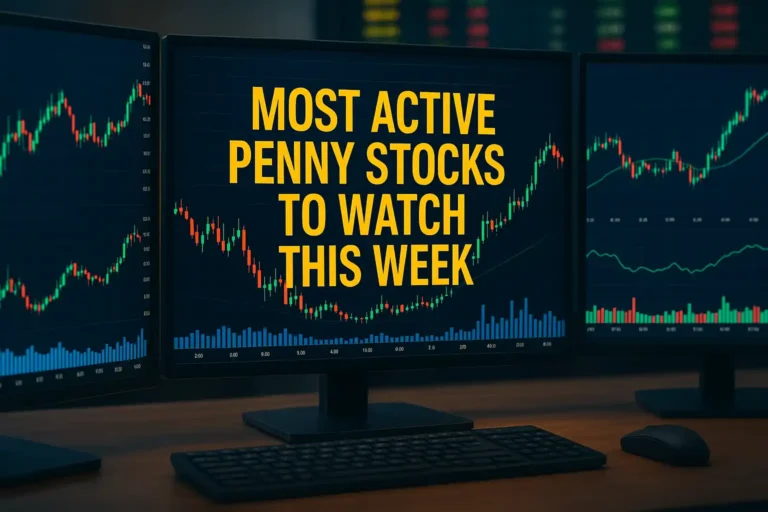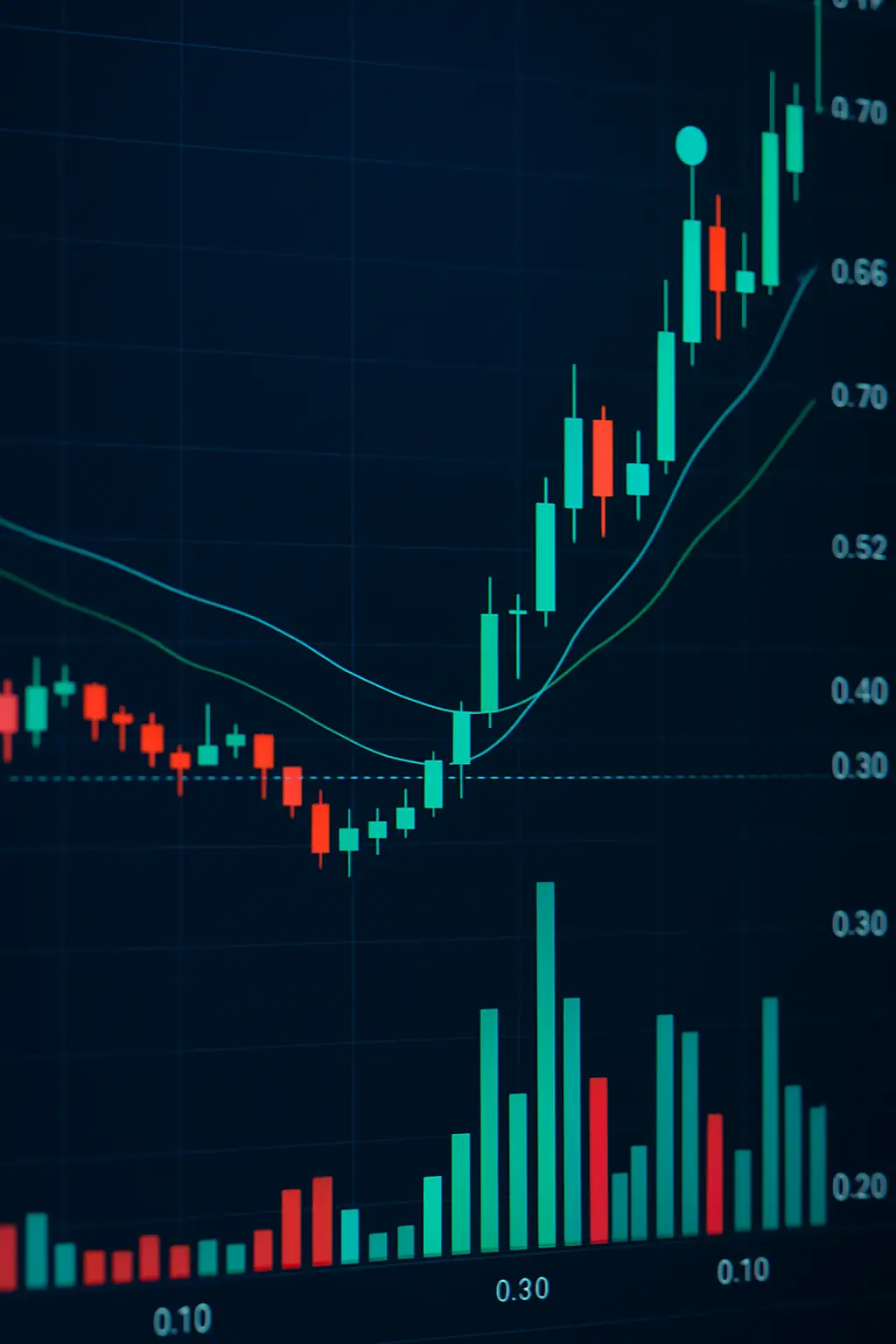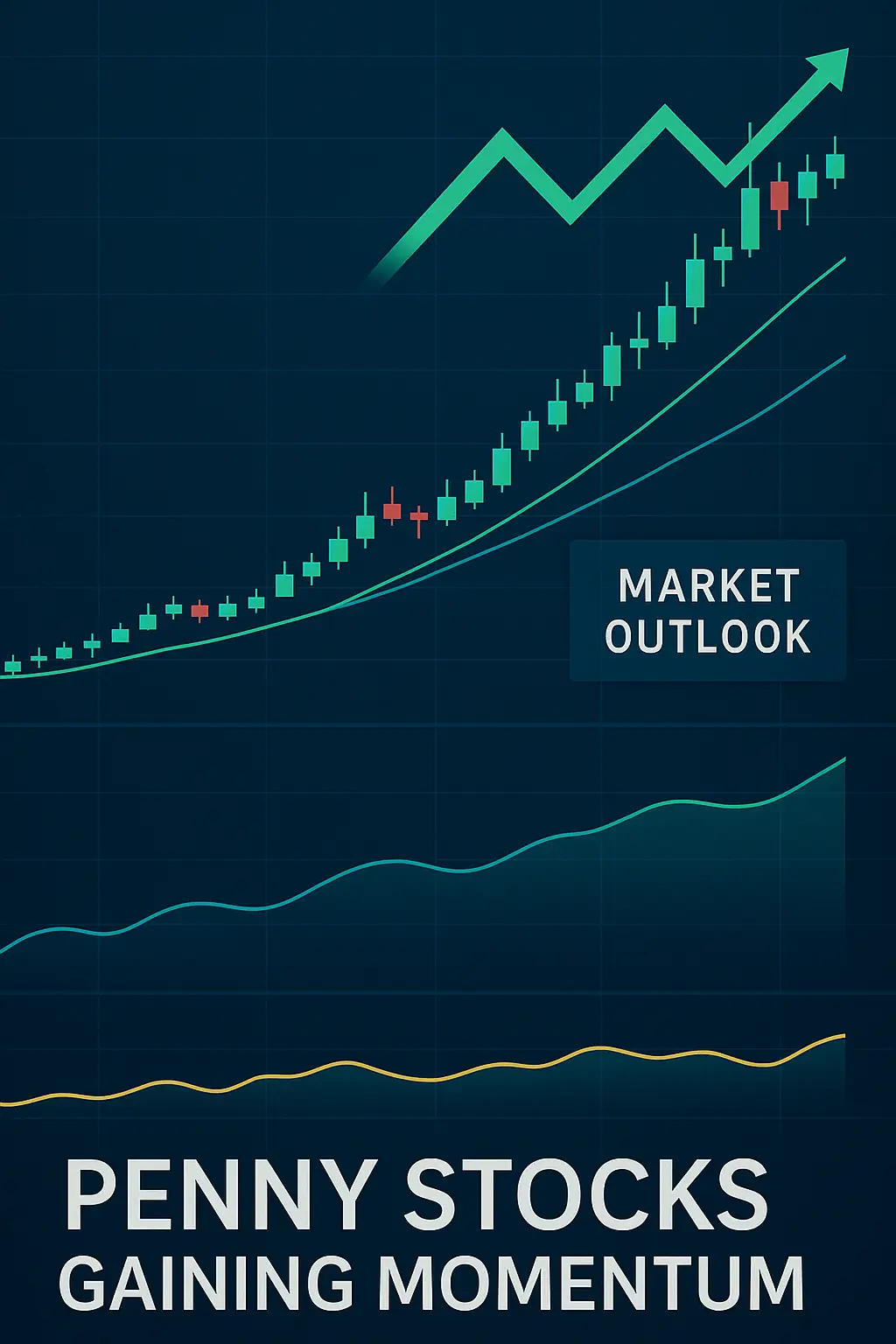
Most Active Penny Stocks to Watch This Week
If you are trying to keep up with the most active penny stocks to watch this week, your real advantage comes from understanding where liquidity, momentum, and catalysts are clustering in real time. These fast-moving setups attract traders because they can move quickly — sometimes delivering major intraday opportunity, but also major risk if you’re not prepared.
Instead of chasing every low-priced ticker that flashes across your scanner, skilled traders narrow in on high volume penny stocks with clear catalysts, clean technical structure, and enough liquidity to enter and exit safely. Volume tells the story — it exposes where traders are positioning and which tickers are gaining attention.
In this weekly breakdown, we’ll outline the stocks showing the strongest activity, the catalysts moving them, and the broader market forces influencing volatility. Use these insights to trade with clarity, not emotion.
Key Points for This Week
- 📈 Spot which penny stocks are trading with unusually high volume and tight spreads.
- ⚡ Identify the catalysts driving this week’s biggest movers — earnings, filings, and sector news.
- 🌐 See how overall market sentiment (major indexes and tech leaders) impacts small-cap volatility.
- 🛡️ Apply risk rules for sizing positions, managing stops, and avoiding low-liquidity traps.
- 📊 Use live charts and watchlists to stay updated as momentum rotates across different tickers.
Market Overview: What’s Driving This Week’s High-Volume Penny Stocks
The surge in the most active penny stocks to watch this week is being fueled by a combination of macro events, sector-specific catalysts, and a noticeable uptick in retail trading volume. When broader markets — such as the S&P 500 and Nasdaq — rotate sharply, liquidity tends to spill over into small-cap and micro-cap names, creating short bursts of volatility and opportunity.
This week, traders are reacting strongly to shifting expectations around interest rates, tech earnings, and metals-sector momentum. Precious and industrial metals have shown increased volatility as global production demand fluctuates, which often correlates with rising interest in cheaper, speculative tickers. For example, our analysis of sector rotation trends aligns with insights from this silver rally trading strategy breakdown, which highlights how volatility in metals often influences penny stock momentum.
Another major driver has been the rise in biotech, clean energy, and EV-adjacent small caps. These sectors produced several unusual-volume spikes following newly filed 8-K reports, clinical trial updates, or partnership announcements. When small caps enter a catalyst cycle, volume can climb rapidly — sometimes 500% or higher — in a matter of hours.
To illustrate how traders are reacting, here is a real-time chart of one of the week’s most active penny stocks, showing the volume footprint that has captured trader attention.
This live chart shows exactly how volume and liquidity are clustering. Large green volume bars indicate moments when retail traders flood into the stock, often following catalysts such as filings, interviews, analyst mentions, or social media attention. Understanding the timing of these volume surges is crucial for anyone trading high volume penny stocks during active market periods.
Deep Dive: High Volume Penny Stocks Leading This Week’s Action
Once you understand the broader backdrop, the next step is to focus on specific high volume penny stocks that are actually leading this week’s tape. The most active penny stocks to watch this week typically share three traits: expanding volume, clear technical levels, and a catalyst that explains why traders are suddenly paying attention.
Many of the high volume penny stocks on today’s screens are clustered in sectors tied to growth narratives—such as clean energy, critical metals, biotech, and early-stage tech. When headlines point to new demand, regulation changes, or technological breakthroughs, active small cap stocks in those sectors often become short-term momentum leaders as traders rush in to price the news.

A common pattern you will see on these charts is a period of quiet, sideways trading followed by a sudden increase in both price and volume. That transition phase is where penny stocks gaining momentum separate themselves from the rest of the low-volume noise. The faster volume expands relative to the stock’s recent history, the more likely it is attracting new traders and algorithms.
It is also important to consider how these names fit into a broader portfolio of speculative ideas. For example, some traders pair active small cap stocks in technology or biotech with positions in metals and crypto-linked assets to diversify their risk and avoid concentrating all of their exposure in one theme. Our diversified crypto and metals portfolio guide shows how different high-volatility assets can complement short-term penny stock trades rather than compete with them.
As you review charts, pay close attention to:
- Whether the day’s biggest moves are happening on increasing or decreasing volume.
- How tight or wide the spreads are during peak activity, especially at the open.
- Whether breakouts are holding above prior resistance levels or failing quickly.
- How often the stock has been halting due to volatility, which can impact fills and exits.
By focusing on a short list of genuinely active names instead of dozens of illiquid tickers, you give yourself a better chance to manage risk, read the tape, and respond confidently as new information hits the market.
Momentum Shifts: Ranking the Most Active Penny Stocks to Watch This Week
After identifying which high volume penny stocks are attracting early attention, the next step is to determine which of them have enough momentum, liquidity, and catalyst strength to stay in focus throughout the week. Market momentum is rarely static—volume rotates quickly, especially in small caps—so tracking these shifts is crucial when deciding which tickers belong on your watchlist.
Many of the most active penny stocks to watch this week are showing accelerated price action due to strong catalysts: updated SEC filings, partnership announcements, sector-driven demand, or early-stage revenue surprises. When these catalysts align with expanding liquidity, traders often see multi-hour moves that offer cleaner setups and more predictable behavior.
Below is a live chart of another one of this week’s active small cap stocks. Notice how volume expansion aligns with technical levels such as intraday VWAP, premarket highs, and prior day resistance. These areas become critical decision points for both breakout traders and short sellers.
As traders analyze charts like this, they look for recurring patterns such as higher lows into resistance, early-session reclaim of key levels, and whether volume remains elevated after the morning rush. Sustained buying pressure during midday hours is one of the clearest signs that penny stocks gaining momentum may continue building strength into the close.
Traders should also pay attention to theme-driven momentum. When certain sectors heat up—such as EV components, battery metals, or energy storage—related penny stocks often experience correlated spikes. Our breakdown on critical metals and the EV boom shows how these macro trends can funnel liquidity into early-stage small caps and create rapid, short-term opportunities.
Momentum ranking criteria for this week include:
- Volume consistently holding above the 5-day average.
- Strong premarket activity with clean consolidation zones.
- Breakouts that retest and hold major intraday levels.
- Reduced selling pressure after morning moves, showing buyer control.
- Sector correlations that amplify demand for multiple related tickers.
Combining these technical and catalyst-based signals gives traders a clearer picture of which tickers are likely to deliver actionable setups and which ones are simply experiencing temporary noise. The goal is not to trade everything moving, but to focus on structurally sound setups backed by meaningful liquidity.
Trading Playbook: How to Approach the Most Active Penny Stocks This Week
By this point, you should have a clear sense of which tickers belong on your watchlist and how volume has been rotating between sectors. The final step is turning that information into a practical trading plan. Instead of reacting to every spike you see on a scanner, build a structured approach for the most active penny stocks to watch this week so you know exactly when you will trade, how you will size, and when you will step aside.
A simple framework is to separate your watchlist into three tiers: primary setups, secondary backups, and “just watching” ideas. Primary setups are high volume penny stocks with clear catalysts, multi-timeframe support, and clean levels you can trade around. Secondary setups may have good volume but weaker catalysts or choppier price action. Everything else stays on a passive radar so you do not clutter your focus during the trading day.

As you evaluate penny stocks gaining momentum, focus less on how far they have already moved and more on how they behave at key intraday levels: opening range highs and lows, premarket support and resistance, VWAP, and prior day close. Strong, active small cap stocks will often respect these zones, pausing or consolidating before attempting another leg higher. Weak names tend to slice through levels with erratic, low-quality price action.
Practical Guidelines for This Week’s Trading Sessions
To translate the week’s setups into a consistent process, use guidelines like these:
- Define your A+ setup. Decide what a high-quality trade looks like in advance—volume, catalyst, pattern, and risk level—so you are not improvising mid-session.
- Cap your position size. Use smaller size on thinly traded names and slightly larger size only on the most liquid high volume penny stocks with tight spreads.
- Anchor your risk to structure. Place stops beyond logical levels (support, resistance, or VWAP), not random dollar amounts.
- Respect circuit breakers and halts. If a stock is halting repeatedly, assume fills and exits will be harder, and adjust size—or stay out—accordingly.
- Have an exit before entry. Know your profit targets and invalidation points before you click buy or sell.
One of the biggest edges you can gain when trading the most active penny stocks to watch this week is simply having a routine. Start each day by scanning for fresh gappers, align them with your existing list, and remove names that have lost both volume and relevance. This keeps your attention on current opportunities instead of yesterday’s excitement.
Short-Term Outlook for Active Small Cap Stocks
Looking ahead, the short-term outlook for active small cap stocks will likely depend on a few key variables: whether broader indexes can hold recent support levels, how interest-rate expectations shift, and how strong upcoming earnings and economic data appear. If risk-on sentiment continues, traders may see repeated waves of momentum in speculative names as capital rotates down the market-cap ladder.
On the other hand, if volatility in the major indexes spikes due to negative headlines or macro surprises, many traders will reduce risk and shrink position size across the board. In that environment, the best opportunities may come from selectively trading only the cleanest, most liquid high volume penny stocks and avoiding crowded, low-float tickers prone to violent reversals.
The goal is not to predict every move, but to stay prepared. By combining sector awareness, volume analysis, and disciplined risk management, you can treat volatility as a tool rather than a threat—and use this week’s activity to refine a repeatable approach for the weeks ahead.
Frequently Asked Questions
1. What makes a penny stock “active” during the week?
A penny stock becomes “active” when its trading volume increases significantly above its recent average. This can happen due to catalysts such as earnings updates, SEC filings, sector momentum, or sudden increases in retail and algorithmic trading activity.
2. Why does volume matter when trading penny stocks?
Volume determines liquidity, which affects how easily you can enter and exit positions. High-volume penny stocks typically have tighter spreads and fewer liquidity traps, making them safer and more tradable than thinly traded stocks.
3. What sectors usually produce the most active penny stocks?
Historically, biotech, clean energy, mining, EV technology, AI-related microcaps, and financial technology produce frequent high-volume runners. These sectors generate fast-moving catalysts that attract traders.
4. How long do momentum spikes usually last?
Momentum spikes can last anywhere from a few minutes to multiple days. The most dependable setups tend to come from stocks with strong catalysts that sustain interest beyond the initial run-up.
5. Are low-float penny stocks better to trade?
Low-float stocks can move explosively, but they also carry higher risk due to wide spreads and halts. Many traders prefer mid- or higher-float penny stocks with consistent liquidity for safer entries and exits.
6. How many penny stocks should I watch at once?
Most traders focus on 3–6 genuinely active tickers. Watching too many lowers reaction speed and increases emotional decision-making, especially during high-volatility hours.
7. What is the safest way to trade active small-cap stocks?
Use smaller size, trade only the most liquid setups, anchor stops to support/resistance, and avoid chasing parabolic moves. Liquidity and discipline matter far more than price level.
8. Do penny stocks follow the broader market?
Yes. Strong risk-on sentiment in major indexes often fuels momentum in speculative names, while market fear or uncertainty can dry up liquidity quickly.
9. Is it better to trade penny stocks at open or mid-day?
Many traders prefer the opening volatility window, but mid-day trends can also offer clean setups once early noise settles. The key is adapting to volume conditions rather than forcing trades during slow periods.
10. How do I avoid getting trapped in halts?
Avoid chasing vertical moves and low-float parabolic spikes. Watch for repeated halts in a short time period— this is often a sign of dangerous imbalance between buyers and sellers.
Conclusion
Trading the most active penny stocks to watch this week requires a balance of preparation, pattern recognition, and risk control. By focusing on high-volume runners with meaningful catalysts and avoiding low-liquidity traps, you give yourself the best chance to trade confidently and avoid unnecessary risk.
As always, the goal isn’t to trade every mover—it’s to trade only the cleanest setups supported by liquidity, structure, and a repeatable process. Keep refining your watchlist, track how volume shifts throughout the day, and use these insights to stay one step ahead of fast-moving small-cap trends.
📩 Want more weekly breakdowns like this? Join our Trade Stock Alerts newsletter for real-time updates.

Pauline Lei
Market analyst and lead writer at TradeStockAlerts.com. Pauline specializes in penny stocks, momentum trading, and high-volume market analysis. She focuses on identifying liquidity shifts, breakout patterns, and catalyst-driven moves in small-cap and micro-cap stocks — helping traders navigate fast-moving markets with clarity and discipline. Her research blends real-time data, technical structure, and risk-managed strategies designed for today’s high-volatility trading environment.